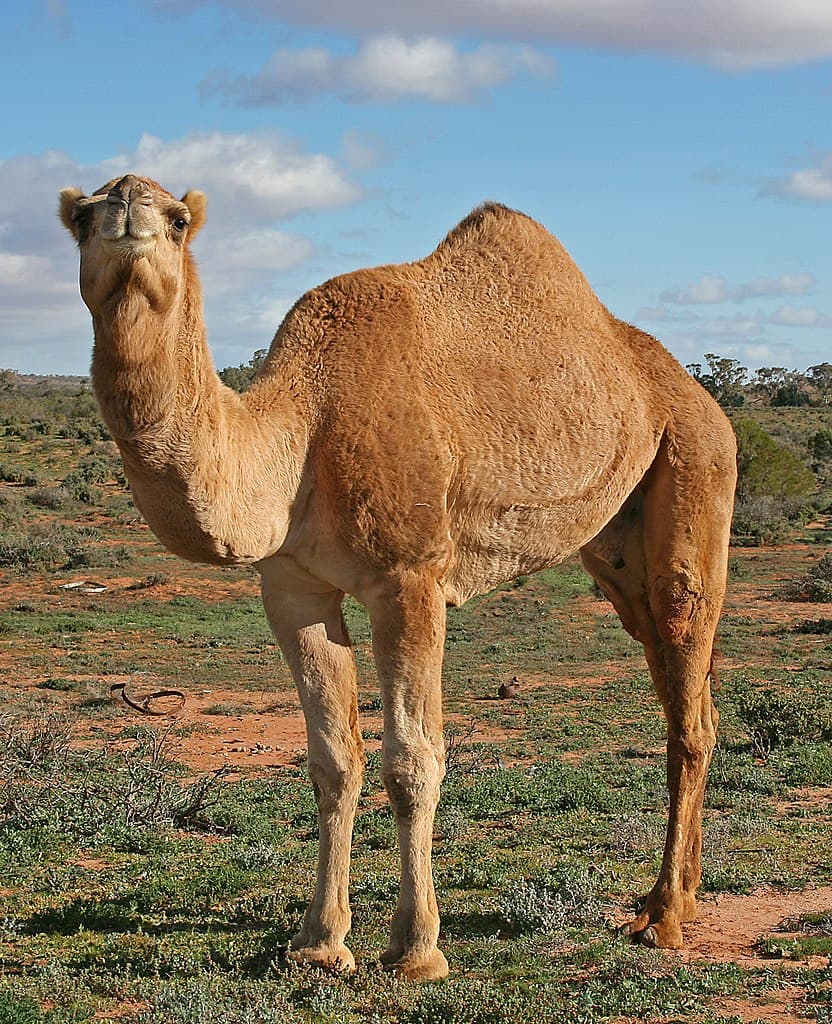Are you looking for Desert Animals? We collected the Top 10 Desert Animals here.
As indicated by researchers, a desert is a spot that consistently gets under ten creeps of a downpour. In any case, not all deserts are similar. They can be stony, windblown deserts that are aloof to living animals.
Some deserts are loaded with plants, particularly ones that have advanced to hold water, like desert flora and different succulents.
There are hot, sandy abandons called ergs. A large part of the Sahara desert is an erg.
Click below to jump to any section on the top 10 animals in the desert:
#1 Dromedary Camel
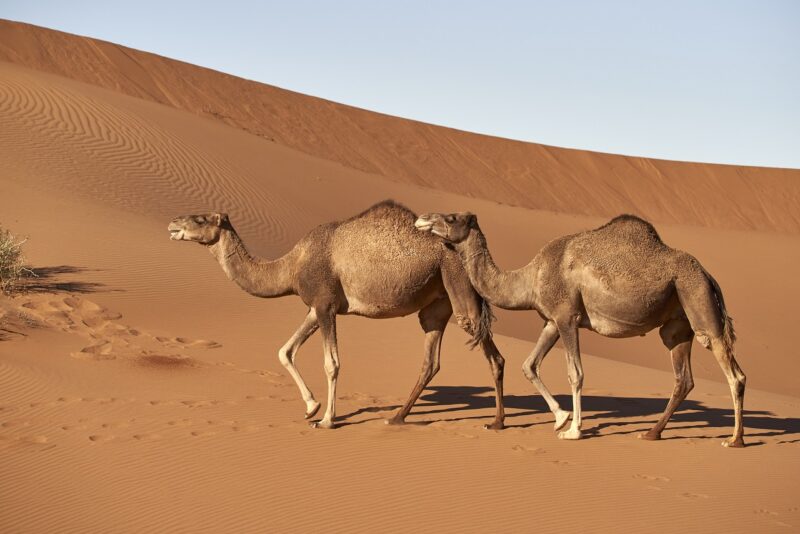
About Dromedary Camel
- Scientific name: Camelus dromedarius
- Weight: 400-60kg
- Gestation period: 15 months
- Lifespan: 40 years
- Trophic level: Herbivorous
The mound saves 80 pounds of fat, which a camel can separate into water and energy when food isn’t free. These mounds empower camels to go up to 100 desert miles without water. Camels seldom sweat, even in desert temperatures that reach 120°F, so they can monitor them for significant stretches of time when they truly do take in liquids.
In winter, even desert plants might hold sufficient dampness to permit a camel to live without water for a considerable time. At the point when camels do top off, in any case, they absorb water like a wipe. An exceptionally parched creature can hydrate in just 13 minutes. Other variations assist dromedaries with flourishing in desert conditions.
Their noses keep sand under control, and they have thick eyebrows and two columns of long eyelashes to safeguard their eyes. Huge, extreme lips empower them to pick at dry, prickly desert vegetation. Enormous, thick footpads assist them with exploring the unpleasant rough landscape and moving desert sands. Middle Eastern camels have been trained for around 3,500 years and have been for quite some time esteemed as pack creatures.
They can convey huge burdens for up to 25 miles per day. A few societies judge an individual’s abundance in light of the number of camels they own. Today, virtually all the world’s camels are homegrown creatures. They are tracked down in northern Africa and southwestern Asia and have been acquainted with Australia.
Read on for more info on the top 10 animals in the desert.
Where can one find Dromedary camel?
Dromedary camels live in the Sahara Desert and other dry areas of Africa, the Middle East, and northern India. Additionally, they were brought to arid areas of central Australia, where some of the last remaining wild populations can be found today.
#2 Scorpion

About Scorpion
- Scientific name: Scorpiones
- Phylum: Arthropoda
- Higher classification: Dromopoda
- Rank: Order
- Kingdom: Animalia
There are nearly 2,000 scorpion species. However, just 30 or 40 have sufficient toxins to kill an individual. The many kinds of toxins are custom fitted to their clients’ ways of life, nonetheless, and are profoundly chosen for viability against that species’ picked prey. Scorpions commonly eat bugs. However, their eating regimen can be a factor — one more key to their endurance in such unforgiving areas.
When food is scant, the scorpion can astonish to ease back its digestion to just 33% of the common rate for arthropods. This strategy empowers a few animal groups to utilize little oxygen and live on as little as a solitary bug each year.
However, even with brought down digestion, the scorpion can spring rapidly to the chase whenever the open door introduces itself — a gift that many sleeping species need. Such survival abilities permit scorpions to live in a portion of the planet’s most challenging surroundings.
Analysts have frozen scorpions short-term, to place them in the sun the following day and watch them defrost and leave. Be that as it may, there is one thing scorpions struggle with living without — soil. They are tunneling creatures, so in areas of permafrost or weighty grasses where free soil isn’t accessible, scorpions will most likely be unable to get by.
Read on for more info on the top 10 animals in the desert.
Where can one find a scorpion?
Grasslands, savannas, and woods are only a few of the temperate, subtropical, and tropical habitats that scorpions have evolved to in addition to desert conditions. Other than Greenland and Antarctica, they are found on all major landmasses.
#3 Yucca Moth
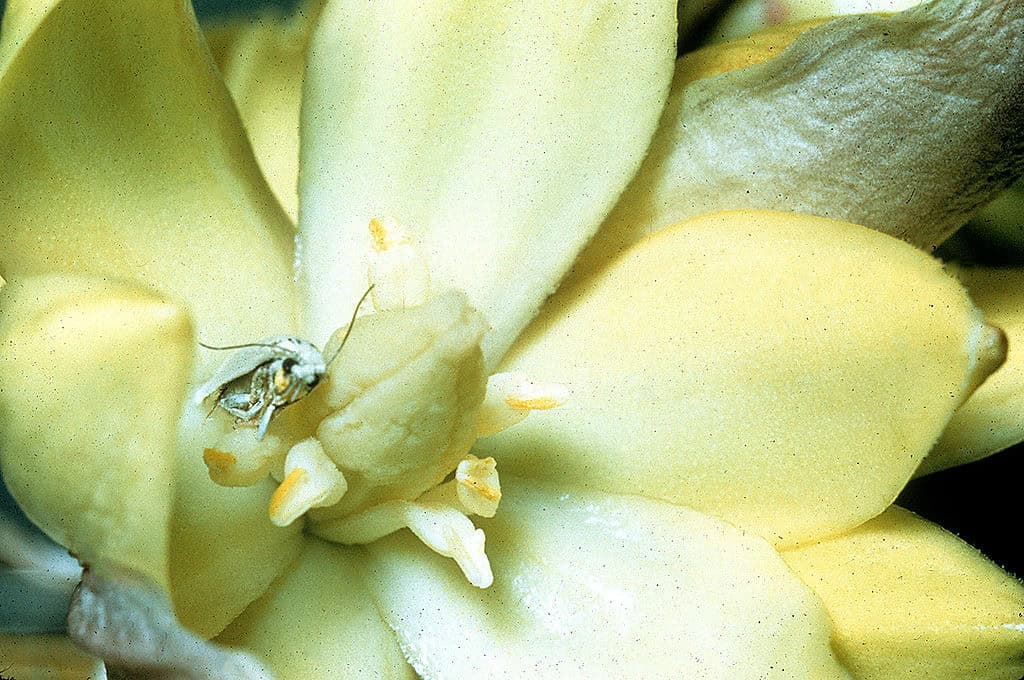
About Yucca Moth
- Scientific name: Tegeticula yuccasella
- Rank: Species
- Kingdom: Animalia
Yucca moths assume a significant part in the endurance of yucca plants. Without the yucca moth, the yucca plant would lose its just pollinator, and without the plant, the moth would lose its food source. Each relies upon the other for endurance. Most yucca moths have white wings to mix with the rich blooms of the plants they fertilize.
As caterpillars, they are rosy pink and stout, with no particular examples. Grown-up yucca moths don’t live extraordinarily long and, consequently, don’t have to take care of. Caterpillars feed on yucca seeds. She utilizes extraordinary limbs around her mouth to convey the cluster of dust to one more bloom on an alternate plant. In the wake of guaranteeing that no different females have visited the bloom, she stores the dust on the blossom’s disgrace, which prepares it.
The yucca moth contrasts from different moths in that it has no long, examining tongue. It has antennas around the mouth that don’t resist feeding because the moth doesn’t eat but assists the females with gathering dust.
She goes to another plant when she has a decent piece of dust. She reviews the blossoms there, and if there are no eggs in the ovary, she’ll store a couple and add dust to the shame of the bloom. This allows the bloom to create organic products, which will take care of her caterpillars when they hatch.
After the caterpillar has brought forth and benefited from the products of the soil of the yucca, it tumbles to the ground, dives in, and winds around a cover around itself, where it will remain till the following spring or longer. When the new moth arises, it will be while the yucca blooms.
Read on for more info on the top 10 animals in the desert.
Where can one find Yucca moth?
Yucca moths are indigenous to the Southwest, but yucca plants have helped to increase their range north and east. The presence of yucca plants is a crucial aspect of the moth habitat. The Joshua tree is one of their most recognizable mates in the Southwest. Birds and bats frequently eat yucca moths.
#4 Sidewinder
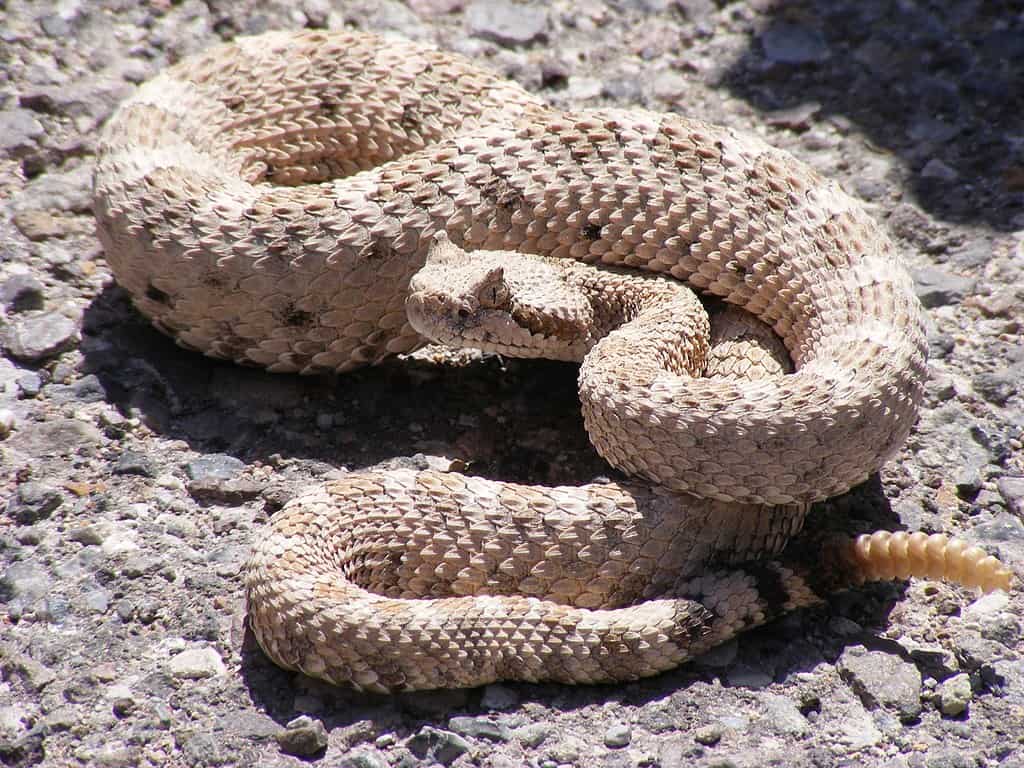
Mojave Desert Sidewinder (Crotalus cerastes ssp. cerastes). Subspecies of reptile. Image via Philip Kahn, CC BY-SA 4.0 https://creativecommons.org/licenses/by-sa/4.0, via Wikimedia Commons
About Sidewinder
- Scientific name: Crotalus cerastes
- Species: C. cerastes
- Phylum: Chordata
- Kingdom: Animalia
- Family: Viperidae
- Order: Squamata
Sidewinders are noted for their novel strategy for velocity, which leaves a trademark j-molded trail. Circles of the body are tossed diagonally across the sand, so just two focuses are in touch with the ground whenever. This keeps the snake from overheating because of unreasonable contact with the desert sand. Even though they are venomous, their nibble is usually not lethal to people.
Read on for more info on the top 10 animals in the desert.
Where can one find Sidewinder?
The sidewinder (Crotalus cerastes), often referred to as the horned rattlesnake and sidewinder rattlesnake, is a type of poisonous pit viper found in the desert areas the Southwestern United States and northwest Mexico.
#5 Roadrunner
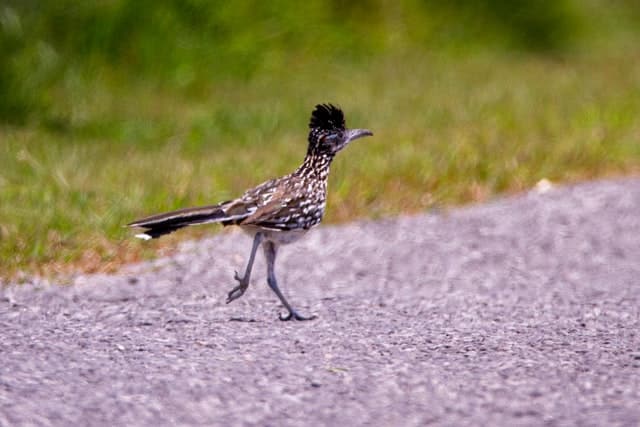
About Roadrunner
- Scientific name: Geococcyx
- Higher classification: Cuckoos
- Family: Cuculidae
- Subfamily: Neomorphinae
- Rank: Genus
The most famous bird in the southwest is highlighted in old stories and kid’s shows, known for its long tail and expressive peak. The Roadrunner strolls and runs on the ground, flying just when vital. It can run 15 miles each hour, likely with much quicker sprays while pursuing a quick-running reptile or prey.
Its ability as a poisonous snake warrior has been dramatically misrepresented. However, it eats a surprising assortment of more modest animals. May mate forever matches safeguarding an area throughout the year. Romance remembers pursuing foot, with regular stops to rest.
One bird (either sex) approaches the other with a stick or piece of sod, drops it on the ground, or gives it to the other bird. In different presentations, the male takes off from the female with the tail and wings raised over the back and, step by step, brings down the wings; the male sways his tail from one side to another while gradually bowing.
The home site is in the thick hedge, low tree, or cactus, generally 2-12′ over the ground, seldom on the ground. Home is a foundation of sticks, fixed with grass, leaves, feathers, and now and then with snakeskin or bits of cow compost.
Typically chases by strolling quickly, searching for prey, then, at that point, making an extremely fast scramble forward to get prey in its bill. May jump straight up from the ground to get bugs or birds flying over (has been seen getting hummingbirds this way), including bugs, reptiles, rodents, and birds.
Benefits from numerous giant bugs and different arthropods, including scorpions, tarantulas, and centipedes. Likewise, there are numerous reptiles, snakes, mice, youthful ground squirrels, little birds (counting child quail and grown-up sparrows), and snails here and there. Eats a few organic products (particularly desert plant leafy foods.
Read on for more info on the top 10 animals in the desert.
Where can one find a roadrunner?
Larger roadrunners can be found year-round in Texas, Oklahoma, New Mexico, Arizona, and southern California. On the ground or perched on common objects, such as fences, they can be observed in grasslands, scrub, and deserts. Roadrunners are preyed upon by hawks, raccoons, and, of course, coyotes.
#6 Saiga

Wild saiga antelope, Saiga tatarica tatarica visiting a waterhole at the Stepnoi Sanctuary, Astrakhan Oblast, Russia. Image via Andrey Giljov, CC BY-SA 4.0 https://creativecommons.org/licenses/by-sa/4.0, via Wikimedia Common
About Saiga
- Scientific name: Saiga tatarica
- Family: Bovidae
- Order: Artiodactyla
- Phylum: Chordata
- Kingdom: Animalia
- Tribe: Saigini
It’s enormous, it’s bulbous, and it’s a clever transformation! The astounding proboscis-like saiga nose wraps over its mouth and focuses descending. The bones within the nose are mind-boggling and tangled, and the nasal openings are fixed with hairs, organs, and mucous plots. Every nostril is a sac fixed with mucous films. This puzzling gag might assist the saiga with heating up, breathing in the bone-chilling winter air and channeling out dust during the parched mid-year months. Of course, the saiga has a sharp feeling of smell.
The saiga has weighty, fleece-like fur with an edge of long, monitor hairs from the jaw to the chest. Throughout the mid-year, it is cinnamon buff on the highest point of the body with more obscure fur on the face and nose.
The back end, tail, and underparts are velvety white. In the colder time of year, the coat is thicker and consistently pale in variety. Guys have vigorously furrowed, golden-shaded horns that grow 6 to 10 inches long. Tragically, they have intensely pursued this adornment. This pronghorn has long, flimsy legs but is comparable in size to a sheep.
Read on for more info on the top 10 animals in the desert
Where can one find saiga?
Most of the species’ current distribution is restricted to the grasslands and deserts of Kazakhstan and some areas of Uzbekistan, Russia, and Mongolia.
#7 Antelope Jackrabbit

About Antelope jackrabbit
- Scientific name: Lepus alleni
- Family: Leporidae
- Order: Lagomorpha
- Phylum: Chordata
- Kingdom: Animalia
The Antelope rabbit is a North American bunny named after the quick-running eland. These creatures are additionally known for having the option to run and jump rapidly. Like elands, these rabbits additionally show streaks, as they run, of their white underside.
They are one of five types of a hare that occupy various locales of North America. They are possibly the most excellent bunny and are more significant than hares. They make their homes over the ground. The eland rabbit, a bunny, lives in the deserts of southern Arizona and the northwest of Mexico.
It favors regions with desert bushes that shade grasses yet can be tracked down in additional forlorn districts. It is an enormous bunny with dark flanks, a dark back, and an orange on its chest and neck.
It has a white midsection and can be around 22 inches long with a 3-inch tail. It can weigh as much as 9 pounds and has surprisingly long ears for a bunny or a rabbit. It easts desert flora and other plant material and has sometimes been seen eating the dirt for minerals.
Read on for more info on the top 10 animals in the desert.
Where can one find antelope jackrabbit?
The Sonoran Desert is home to the desert cottontail, which prefers densely forested areas with many hiding spots. The desert’s drier regions, such as creosote bush flats, mesquite grassland, and cactus plains into and beyond southern Sonora, are home to the antelope jackrabbit.
#8 Tadpole Shrimp

Triops cancriformis, European Tadpole Shrimp, Subspecies from Spain. Image via Dat doris, CC BY-SA 4.0 https://creativecommons.org/licenses/by-sa/4.0, via Wikimedia Commons
About Tadpole shrimp
- Scientifc name : Notostraca
- Class: Branchiopoda
- Order: Notostraca; G. O. Sars, 1867
- Phylum: Arthropoda
- Kingdom: Animalia
Fledgling shrimp is an expert in transitory lakes. In addition to the fact that they are equipped for enduring long dry spell periods, they entirely lakes to dry in the middle between years to set off incubating. Populaces of hunters and contenders can’t develop in brief lakes as they can in long-lasting lakes.
Alongside the new water and turnover of supplements in the customarily brushed destinations where they happen, it makes the perfect mixed drink for them to flourish. These astonishing creatures have an exceptional lifecycle.
During the months, their impermanent lakes stay dry, and their eggs lay torpid, sitting tight for the downpours. Yet again, once their lakes fill, they burst forward, rapidly developing and rearing before their lakes dry out and their short lives come to a nearby. Their eggs are extraordinarily all around adjusted to their circumstances.
Just an extent of eggs will incubate each time a lake loads up with water. A few eggs will stay torpid for a long time, at times many years. This intends that if a lake dries out before the grown-ups have the opportunity and energy to rise, everything isn’t lost, and the cycle can proceed with the following time the lake fills.
Read on for more info on the top 10 animals in the desert.
Where can one find Tadpole shrimp?
It is found in ponds, pools, and lakes.
#9 Merriam’s Kangaroo Rat

About Merriam’s Kangaroo Rat
- Scientific name: Dipodomys merriami
- Conservation status: Least Concern
- Mass: 38 g
- Trophic level: Herbivorous
- Length: 9.9 cm (Adult)
- Gestation period: 31 days
Kangaroo rodents have long tails and large rear feet with four toes. They have enormous heads with huge eyes and little ears. They are a sandy earthy colored tone with a white underside. The kangaroo rodent is impeccably adjusted to life in the desert.
They can get by while never drinking water, getting the required dampness from their seed diet. They have great hearing and can distinguish the soft solid of an owl, drawing closer. Their enormous back legs empower them to hop up to 9 feet in a single leap to escape hunters. Kangaroo rodents possess an assortment of desert specialties.
These can incorporate open desert scour, open meadows, washes, sandy soils or creosote pads. Kangaroo rodents are tracked down in the drier locales of the western and southwestern U.S.
The kangaroo rodent isn’t imperiled. Its status in the wild is excellent at this moment. Kangaroo rodents eat seeds from an assortment of desert grasses and mesquite beans. Occasionally, some kangaroo rodents will eat green vegetation and a few bugs.
Read on for more info on the top 10 animals in the desert
Where can one find Merriam’s Kangaroo rat?
The upper and lower Sonoran life zones of the southwest United States, Baja California, and northern Mexico are home to Merriam’s kangaroo rats.
#10 Sand Cat

About Sand Cat
- Scientific name: Felis margarita
- Order: Carnivora
- Phylum: Chordata
- Kingdom: Animalia
- Family: Felidae
- Subfamily: Felinae
The desert is where one of the world’s most intriguing and impressive felines resides, the Sand feline. However, it seems to be a homegrown feline with the expansion of fuzzy paws, monster ears, and an exceptionally inquisitive character. These felines are little and stocky, with short legs and a generally lengthy tail.
Their fur is mostly a pale sandy tone, generally with a white stomach. Their feet are thickly furred, which is remembered to assist them with adapting to the desert’s outrageous temperatures-like wearing shoes to stroll on a hot black-top. Sand felines eat little rodents, sometimes bunnies, birds, bugs, and reptiles.
They are dauntless snake trackers — their prey can incorporate venomous snakes and different snakes. Living in moderately forsaken natural surroundings, sand felines are sharp feeders due to legitimate need. In the same way as other desert-staying species, sand felines can make do without drinking water for a long time at a time.
They will instead get any dampness they need from their prey. Sand felines chase by creeping near the ground and utilizing their improved feeling of hearing to identify prey. Hints of a potential feast tunneling under the ground trigger sand felines to dig quickly to uncover and catch prey.
Upon catch, they might cover its kill and return later to take care of it. Like other desert animals, the sand feline of north Africa and west, focal, and south Asia has advanced to require no water. It gets most of its dampness from its food, which comprises more modest, evolved creatures like jerboas, birds, and reptiles.
It’s tiny for a wild feline, with a length of 18 and 22.5 inches and a load of 3.25 and 7.75 pounds. It has a sand-shaded cover with dark stripes on its legs, and a red streak runs from the edge of its eye to its cheek. It is nighttime and rests in a tunnel during the day.
Read on for more info on the top 10 animals in the desert.
Where can one find a Sand cat?
The Sahara desert in Africa, which extends through Algeria, Niger, Morocco, the entire Arabian peninsula, and areas of central Asia, including Turkmenistan, Iran, Pakistan, and Afghanistan, is home to sand cats.
Summary of Top 10 Animals in the Desert
Additionally, mild deserts get barely good downpours to help woody bushes but not grasses. Not all deserts are hot, and even Antarctica can be considered a desert.
Indeed, even a warm desert can get shockingly incredible at night. Creatures worldwide have advanced to live in these deserts, and the following are ten.
Additionally, mild deserts get barely good downpours to help woody bushes but not grasses. Not all deserts are hot, and even Antarctica can be considered a desert. Indeed, even a warm desert can get shockingly incredible at night. Creatures worldwide have advanced to live in these deserts, and the following are ten.
If you enjoyed reading this, check out the top 10 endangered animals in the United States next!
Join our Forum for free today!

- These are The 5 Largest Great White Sharks Ever Recorded - July 19, 2024
- The Surprising Benefits of Big Game Hunting - July 18, 2024
- $100k+ Hunting Experiences The Most Expensive Animals to Pursue - July 17, 2024

